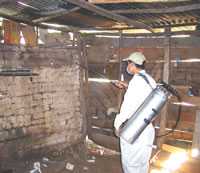Indoor Residual Spraying
Many malaria vectors are considered "endophilic"; that is, the mosquito vectors rest inside houses after taking a blood meal. These mosquitoes are particularly susceptible to control through indoor residual spraying (IRS).
What Is Indoor Residual Spraying?
As its name implies, IRS involves coating the walls and other surfaces of a house with a residual insecticide. For several months, the insecticide will kill mosquitoes and other insects that come in contact with these surfaces. IRS does not directly prevent people from being bitten by mosquitoes. Rather, it usually kills mosquitoes after they have fed if they come to rest on the sprayed surface. IRS thus prevents transmission of infection to other persons. To be effective, IRS must be applied to a very high proportion of households in an area (usually >80%).
History of IRS
IRS with DDT was the primary malaria control method used during the Global Malaria Eradication Campaign (1955-1969). The campaign did not achieve its stated objective but it did eliminate malaria from several areas and sharply reduced the burden of malaria disease in others.
Concern over the environmental impact of DDT led to the introduction of other, more expensive insecticides. As the eradication campaign wore on, the responsibility for maintaining it was shifted to endemic countries that were not able to shoulder the financial burden. The campaign collapsed and in many areas, malaria soon returned to pre-campaign levels.
As a result of the cost of IRS, the negative publicity due to the failure of the Malaria Eradication Campaign, and environmental concerns about residual insecticides, IRS programs were largely disbanded other than in a few countries with resources to continue them. However, the recent success of IRS in reducing malaria cases in South Africa by more than 80% has revived interest in this malaria prevention tool.

Indoor residual spraying
- Page last reviewed: November 9, 2012
- Page last updated: November 9, 2012
- Content source:


 ShareCompartir
ShareCompartir